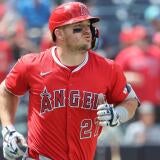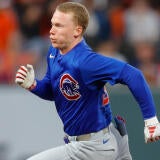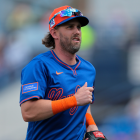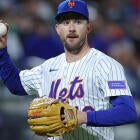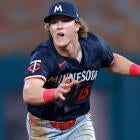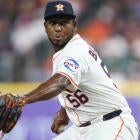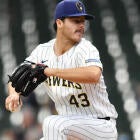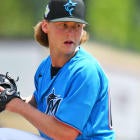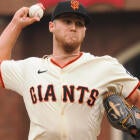If you're drafting for a H2H points league, you've got a pretty simple process: Draft the players who will score the most points at each position. Doesn't matter if a guy hits 40 homers or steals 40 bases, you just need those sweet, sweet Fantasy points.
In Rotisserie leagues, of course, you know it's not so simple. If you just go by the highest-ranked or -projected players, you might look up midway through the draft and find your team is stacked with stolen bases, but lacking in run production; you might find you have a 25% lead on the competition in homers, with a team that's going to hit .240 because you have Joey Gallo, Miguel Sano, and Matt Chapman. In Roto leagues, then, you aren't just looking to draft the best players; the shape of the production matters, too.
You're competing across 10 separate categories at one time, which means you need to know what you're aiming for in each category in order to know how you are keeping pace. Every season is different, but one easy way to do that is to know what results would have won the year before.
So, I pulled the results from all CBS Fantasy 12-team leagues from the 2019 season and averaged the results for each spot in the rankings for every category, which looks like this:
POINTS | AVG | HR | R | RBI | SB | W | S | K | ERA | WHIP |
12 | 0.278 | 383 | 1183 | 1137 | 152 | 103 | 100 | 1622 | 3.497 | 1.131 |
11 | 0.274 | 366 | 1145 | 1104 | 138 | 97 | 89 | 1557 | 3.651 | 1.164 |
10 | 0.272 | 355 | 1125 | 1079 | 128 | 94 | 82 | 1509 | 3.754 | 1.184 |
9 | 0.270 | 345 | 1100 | 1058 | 121 | 91 | 77 | 1470 | 3.834 | 1.200 |
8 | 0.269 | 338 | 1082 | 1041 | 114 | 88 | 71 | 1438 | 3.909 | 1.214 |
7 | 0.267 | 328 | 1064 | 1023 | 108 | 85 | 66 | 1404 | 3.973 | 1.228 |
6 | 0.266 | 324 | 1046 | 1007 | 103 | 83 | 61 | 1370 | 4.041 | 1.242 |
5 | 0.264 | 314 | 1028 | 987 | 96 | 80 | 54 | 1332 | 4.116 | 1.256 |
4 | 0.262 | 305 | 1006 | 964 | 90 | 77 | 48 | 1290 | 4.192 | 1.270 |
3 | 0.260 | 296 | 980 | 942 | 84 | 74 | 40 | 1245 | 4.276 | 1.285 |
2 | 0.258 | 282 | 949 | 910 | 76 | 69 | 31 | 1182 | 4.375 | 1.303 |
1 | 0.254 | 261 | 893 | 855 | 64 | 61 | 18 | 1070 | 4.525 | 1.329 |
Let's go through every category on the hitting side to see what you need to compete — you can find the pitching breakdown here —and how certain players can help you out, beginning with arguably the toughest one to figure out:
Batting Average
POINTS | AVG |
12 | 0.278 |
11 | 0.274 |
10 | 0.272 |
9 | 0.270 |
8 | 0.269 |
7 | 0.267 |
6 | 0.266 |
5 | 0.264 |
4 | 0.262 |
3 | 0.260 |
2 | 0.258 |
1 | 0.254 |
What makes batting average so tough to figure out is that it's all team dependent. You could conceivably target a bunch of Howie Kendrick and Tommy La Stella types, who should hit for a high average but may not play everyday, and dominate the category — you'd also effectively be punting on every other hitting category, so that's a non-starter. However, the more everyday players you have — especially ones who don't walk much — the less any given player can actually help you out in the category.
And then, of course, the amount of at-bats an individual player plays can have an impact on how much that player will help you out in the category. In 2019, the average Roto team got about 7,100 at-bats from their lineup (7,056, to be exact), so the average hitter contributed 504 at-bats to their team's total. Let's take a look at how two hitters with two of the best average hitters in 2020 impacted your typical Fantasy team:
- D.J. LeMahieu: .327 average (197 H/602 AB) = Raised team average from .2662 to .2713
- Howie Kendrick: .344 average (115 H/334 AB) = Raised team average from .2662 to .2700
So, even though Kendrick actually hit 17 points better than LeMahieu in 2019, no player helped their team's batting average more than LaMahieu, thanks to his combination of a high average and the 17th-most at-bats in the league. The ideal candidates to help your average are the ones who rack up a ton of at-bats and hit for a high average — Rafael Devers is another great example.
Stolen Bases
POINTS | SB |
12 | 152 |
11 | 138 |
10 | 128 |
9 | 121 |
8 | 114 |
7 | 108 |
6 | 103 |
5 | 96 |
4 | 90 |
3 | 84 |
2 | 76 |
1 | 64 |
Steals are just about as tricky to land as batting average is, but not for the same reasons. Steals are just an increasingly rare currency in major-league bases, as Scott White has written about recently. In 2017, the leader in steals in your average CBS Fantasy league stole 168 bases; in 2019, that number is down to 152.
Steals are scarce overall, but they also often come in the form of players who just won't help you out much otherwise.
In 2019, 21 players stole at least 20 bases, and 12 of them derived at least 30% of their total value just from stolen bases. Someone like Mallex Smith, who was a major drain in basically every other category and earned a demotion to Triple-A, still provided plus value overall thanks to his stolen base prowess. Smith is the most obvious example, but the likes of Adalberto Mondesi, Jonathan Villar, and Victor Robles are going to go inside of the top-100 on Draft Day in large part due to their ability to steal bases, even though all three could be significant drains on your batting average while providing below-average production in at least two other categories.
This is what pushes the likes of Ronald Acuna and Christian Yelich to the top of draft boards, and what could finally end Mike Trout's reign as the default top Fantasy option. Yelich (30 steals in 131 games) and Acuna (37 steals) both out-gained Trout in overall Roto scoring as well as per-150 game pace scoring, as Trout stole just 11 bases. The last time Trout stole just 11 bases in a season, back in 2015, he followed that up with 30 steals, so you don't want to write him off. However, even Trout's 150-game pace for 2019 would have been good for just sixth in Roto value; each of the players ahead of him stole more bases.
Home Runs
POINTS | HR |
12 | 383 |
11 | 366 |
10 | 355 |
9 | 345 |
8 | 338 |
7 | 328 |
6 | 324 |
5 | 314 |
4 | 305 |
3 | 296 |
2 | 282 |
1 | 261 |
Home runs were more plentiful in 2019 than any season in major-league history, in large part thanks to a ball that, juiced or not, met less air resistance once hit than normal. Add in a league-wide change in approach to maximize power, and you've got a perfect recipe for an unprecedented environment. What that means practically is that, because seemingly every player could hit for power, you needed to hit for substantially more — back in 2017, the average first place team hit 356 homers, 27 fewer than in 2019. In 2017, you needed about eight home runs to move up from one spot in the rankings to the next, on average; in 2019, it took nearly 10.
The average team in 2019 hit 324.8 home runs, or 23.2 per lineup spot. To get to the No. 1 spot, you needed about 27 homers per lineup spot, or an addition of around 42.2, total. No one player could get you there on his own above the average player in 2019, not even Pete Alonso.
Runs
POINTS | R |
12 | 1183 |
11 | 1145 |
10 | 1125 |
9 | 1100 |
8 | 1082 |
7 | 1064 |
6 | 1046 |
5 | 1028 |
4 | 1006 |
3 | 980 |
2 | 949 |
1 | 893 |
RBI
POINTS | RBI |
12 | 1137 |
11 | 1104 |
10 | 1079 |
9 | 1058 |
8 | 1041 |
7 | 1023 |
6 | 1007 |
5 | 987 |
4 | 964 |
3 | 942 |
2 | 910 |
1 | 855 |
Of course, the nice thing about homers is they are highly correlated to run production. 12 of the top 20 in home runs in 2019 also drove in at least 100 runs; nine of the top 20 scored at least 100, too. Unlikely steals and average, you don't really need specialists for these categories — to compete in HR, R, and RBI, you can typically get away with just drafting the top players on your board. If you're drafting home runs and batting average appropriately, runs and RBI should follow.
So which sleepers should you snatch in your draft? And which undervalued first baseman can help you win a championship? Visit SportsLine now to get rankings for every single position, all from the model that called Kenta Maeda's huge breakout last season, and find out.
![[object Object] Logo](https://sportshub.cbsistatic.com/i/2020/04/22/e9ceb731-8b3f-4c60-98fe-090ab66a2997/screen-shot-2020-04-22-at-11-04-56-am.png)




